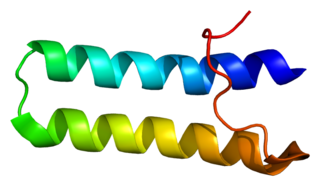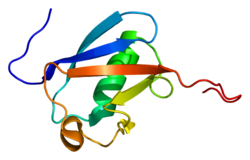
Ribonuclease L or RNase L, known sometimes as ribonuclease 4 or 2'-5' oligoadenylate synthetase-dependent ribonuclease, is an interferon (IFN)-induced ribonuclease which, upon activation, destroys all RNA within the cell. RNase L is an enzyme that in humans is encoded by the RNASEL gene.

Protein kinase RNA-activated also known as protein kinase R (PKR), interferon-induced, double-stranded RNA-activated protein kinase, or eukaryotic translation initiation factor 2-alpha kinase 2 (EIF2AK2) is an enzyme that in humans is encoded by the EIF2AK2 gene on chromosome 2. PKR is a serine/tyrosine kinase that is 551 amino acids long.

Signal transducer and activator of transcription 2 is a protein that in humans is encoded by the STAT2 gene. It is a member of the STAT protein family. This protein is critical to the biological response of type I interferons (IFNs). It functions as a transcription factor downstream of type I interferons. STAT2 sequence identity between mouse and human is only 68%.

2'-5'-oligoadenylate synthetase 1 is an enzyme that in humans is encoded by the OAS1 gene.

Interferon-induced GTP-binding protein Mx1 is a protein that in humans is encoded by the MX1 gene.

Bifunctional aminoacyl-tRNA synthetase is an enzyme that in humans is encoded by the EPRS gene.

Interferon-induced protein with tetratricopeptide repeats 1 is a protein that in humans is encoded by the IFIT1 gene.

Mitochondrial antiviral-signaling protein (MAVS) is a protein that is essential for antiviral innate immunity. MAVS is located in the outer membrane of the mitochondria, peroxisomes, and mitochondrial-associated endoplasmic reticulum membrane (MAM). Upon viral infection, a group of cytosolic proteins will detect the presence of the virus and bind to MAVS, thereby activating MAVS. The activation of MAVS leads the virally infected cell to secrete cytokines. This induces an immune response which kills the host's virally infected cells, resulting in clearance of the virus.

MDA5 is a RIG-I-like receptor dsRNA helicase enzyme that is encoded by the IFIH1 gene in humans. MDA5 is part of the RIG-I-like receptor (RLR) family, which also includes RIG-I and LGP2, and functions as a pattern recognition receptor capable of detecting viruses. It is generally believed that MDA5 recognizes double stranded RNA (dsRNA) over 2000nts in length, however it has been shown that whilst MDA5 can detect and bind to cytoplasmic dsRNA, it is also activated by a high molecular weight RNA complex composed of ssRNA and dsRNA. For many viruses, effective MDA5-mediated antiviral responses are dependent on functionally active LGP2. The signaling cascades in MDA5 is initiated via CARD domain. Some observations made in cancer cells show that MDA5 also interacts with cellular RNA is able to induce an autoinflammatory response.

2'-5'-oligoadenylate synthetase 2 is an enzyme that in humans is encoded by the OAS2 gene.

Bifunctional 3'-phosphoadenosine 5'-phosphosulfate synthetase 2 is an enzyme that in humans is encoded by the PAPSS2 gene.

CDP-diacylglycerol—inositol 3-phosphatidyltransferase is an enzyme that in humans is encoded by the CDIPT gene.

2'-5'-oligoadenylate synthetase 3 is an enzyme that in humans is encoded by the OAS3 gene.

Probable ATP-dependent RNA helicase DHX58 also known as RIG-I-like receptor 3 (RLR-3) or RIG-I-like receptor LGP2 (RLR) is a RIG-I-like receptor dsRNA helicase enzyme that in humans is encoded by the DHX58 gene. The protein encoded by the gene DHX58 is known as LGP2.

RING finger protein 135 is a protein that in humans is encoded by the RNF135 gene.

Z-DNA-binding protein 1, also known as DNA-dependent activator of IFN-regulatory factors (DAI) and DLM-1, is a protein that in humans is encoded by the ZBP1 gene.

CTP synthase 1 is an enzyme that is encoded by the CTPS1 gene in humans. CTP synthase 1 is an enzyme in the de novo pyrimidine synthesis pathway that catalyses the conversion of uridine triphosphate (UTP) to cytidine triphosphate (CTP). CTP is a key building block for the production of DNA, RNA and some phospholipids.

Monofunctional C1-tetrahydrofolate synthase, mitochondrial also known as formyltetrahydrofolate synthetase, is an enzyme that in humans is encoded by the MTHFD1L gene.

In molecular biology, 2'-5'-oligoadenylate synthetase is an enzyme that reacts to interferon signal. It is an antiviral enzyme that counteracts viral attack by degrading RNAs, both viral and host. The enzyme uses ATP in 2'-specific nucleotidyl transfer reactions to synthesize 2'-5'-oligoadenylates, which activate latent ribonuclease (RNASEL), resulting in degradation of viral RNA and inhibition of virus replication.

The mammalian immune system has evolved complex methods for addressing and adapting to foreign antigens. At the same time, viruses have co-evolved evasion machinery to address the many ways that host organisms attempt to eradicate them. DNA and RNA viruses use complex methods to evade immune cell detection through disruption of the Interferon Signaling Pathway, remodeling of cellular architecture, targeted gene silencing, and recognition protein cleavage.























